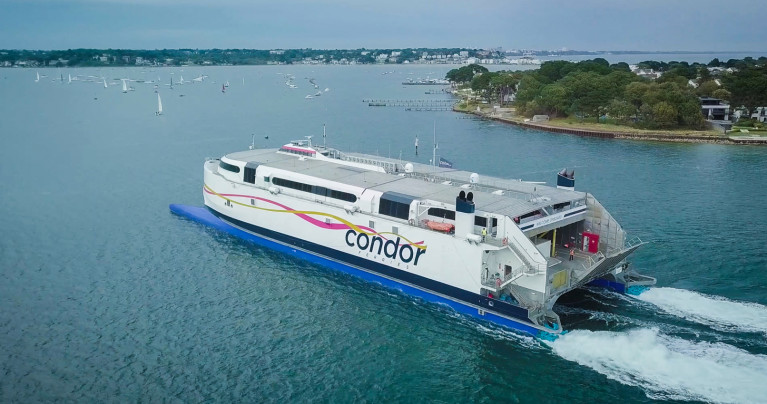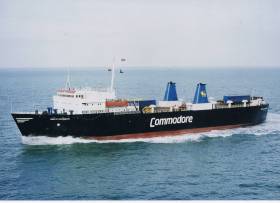Displaying items by tag: UKChannel Islands
The UK ferry port of Portsmouth welcomed MV Condor Islander, the latest vessel in the fleet for Channel Islands operator Condor Ferries.
The former New Zealand Cook Strait ropax arrived at the Hampshire port on 3 August where berthing trials were carried out before the ropax is officially to enter service in the autumn.
Andrew Williamson, Portsmouth International Port’s head of cruise and ferry said: “As a lifeline service to the Channel Islands Condor Ferries plays a crucial role making sure goods and passengers can travel efficiently and safely.
“This second ship in Portsmouth means more choice for both passengers and also extra resilience for freight too.
“Following today’s successful trials we’re looking forward to seeing the Condor Islander back in the autumn when it will be fully operational.”
As a critical shipping route for Channel Island trade, Portsmouth International Port and Condor Ferries recently agreed a new long-term deal, which cements their partnership until 2033. With sailings 364 days a year, the new addition of the Condor Islander and 10-year agreement, provides certainty for this vital freight and passenger service.
John Napton, Condor’s CEO, said, “These trials are important for our crews and shore staff in the various ports to familiarise themselves with the new ship, but she will not be ready for carrying passengers for a few months as refurbishment work is still ongoing.
‘We are making a number of alterations from Islander’s previous operator so there are different requirements involved. Changes include installing a duty-free shop, changes to overnight cabin configurations and refreshing the passenger lounges.”
Condor Islander was acquired by Condor in April 2023 from New Zealand, where she was operating for StraitNZ as the MV Straitsman and positioned to Spain via the Panama Canal. The ferry is a conventional passenger and freight ropax vessel, at 124.9m long and can carry 1,286 lane metres of freight and up to 400 passengers.
Condor has over 75 years’ experience operating services. Its mixed fleet of conventional and high speed ships carry hundreds of thousands of passengers, 200,000 freight vehicles and 65,000 trailers each year between the UK, Guernsey, Jersey and the French ports of St Malo and Cherbourg.
UK-Channel Islands operator, Condor Ferries, has welcomed the newest member to its fleet, Condor Voyager, which arrived in Poole Harbour to begin mooring trials.
Condor Voyager also undertook familiarisation training for Condor’s crews and port staff, prior to the fast-craft's entry into service later this summer.
The former Normandie Express (see Seaglider story) of Brittany Ferries is a 98m long high-speed catamaran which will now be utilised by Condor for its Channel Islands’ and French operations from Poole. (Afloat adds Brittany Ferries acquired a stake in Condor in 2019).
Condor Voyager's catamaran design will provide more capacity for those wishing to travel by sea. The craft having already undergone successful engineering checks and sea trials in the Channel Islands, is one step closer to setting sail as part of Condor Ferries new schedule.
The operator has seen a surge in bookings interest across its ferry and Condor Breaks offerings with Jersey and Guernsey proving popular staycation travel destinations.
Passengers are showing a preference for travelling by sea with health and well-being guidelines in place and confidence in the knowledge that, as standard, all ferry bookings can easily be amended for free up to 48 hours prior to travel.
Elwyn Dop, Condor’s Operations Director, said: “We were delighted to see Condor Voyager arriving in Poole in her Condor livery ready to serve passengers destined for Jersey and Guernsey this summer. Our team and crew will be busy getting her ready for service to start sailing in June and allow extra car and passenger capacity for the additional interest we have had in customers wishing to visit the beautiful Channel Islands. With the rise in staycations and ferry travel, we are certain Condor Voyager will be enjoyed by many people who want to take a stress-free holiday, with no testing and quarantine, onboard a spacious vessel with an outer deck that allows passengers to enjoy the fresh sea air.”
Condor Voyager carries up to 850 passengers and 235 cars. The catamaran can travel at 42 knots and the crossing to the Channel Islands can take around three hours.
UK-Channel Islands Operator Commodore Shipping Celebrates 70 Years of Freight Service
#Condor70th - A UK-Channel Islands freight operator, Commodore Shipping reached a major milestone this year as the company celebrated seven decades of providing lifeline freight services from the mainland.
Now known as Condor Freight, Commodore first appeared on the horizon in 1947. Today the company moves 80% of all supplies taken to the Chanel Islands from the UK on services from Portsmouth International Port.
Commodore’s inaugural service began in September 1947 when its vessel, the ‘Red Commodore’ arrived in St Peter Port Harbour, in Guernsey on charter. She was soon joined by two other ships as the company expanded services to the UK and by 1950, had started to carry passengers between the Channel Islands. Changes embraced over the years include the move from cargo, to container and to the more recent roll-on roll-off (ro-ro) shipping plus the development of shore-side operations.
Condor Freight conveys supplies from the UK to the Channel Islands which includes temperature controlled products, heavy and out of gauge consignments (typically for construction projects), unaccompanied cars and passengers. Our services are maintained on a ‘just in time’ basis as extensive warehousing no longer exists on either Island. This requires close cooperation and liaison with longstanding logistics distributors and other clients to ensure supplies 24/7 and 365 days per year, most of which are transported overnight.
Current services from Portsmouth to Guernsey, Jersey and St Malo are sustained by the freight-only Commodore Goodwill and the mixed passenger and freight ship Commodore Clipper as previously reported on Afloat.ie. Together, these ships cover 3,000 nautical miles each week – the same distance as Portsmouth to New York.
Paul Luxon, Condor’s CEO, said the company’s longevity and success owed much to its willingness to adapt and embrace technology whilst remaining dedicated to the various needs of its customers. “By changing with the times, Commodore has been able to establish itself as a market leader in freight services which encompassed many other operations, including stevedoring, handling and distribution, all in response to the change in demand.”
“The development of ro-ro during the 1990s improved the speed and responsiveness of our services significantly so that these days, our teams can load and offload 80 x 13.6 metre trailers, each containing vital supplies for the Islands, in a fraction of the time it used to take. That’s the equivalent of more than 100 London buses.”
Mr Luxon confirmed that the dedication and loyalty of employees played a big part in the company’s development.
Kalvin Baugh, Ferry Port Manager of Portsmouth international Port, added: “'It's a mark of a good working relationship when milestones such as Commodore's 70th anniversary just seem to come along, so I am delighted we continue to forge an excellent partnership with Paul Luxon and his team and congratulate them on this great achievement.”





























































